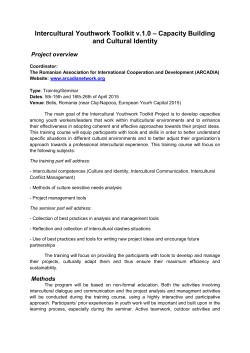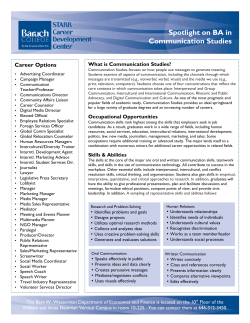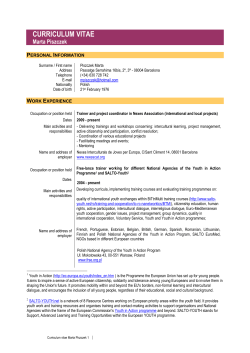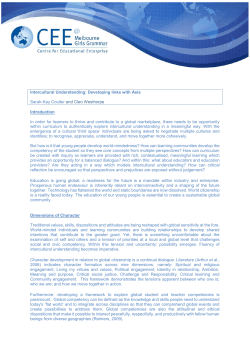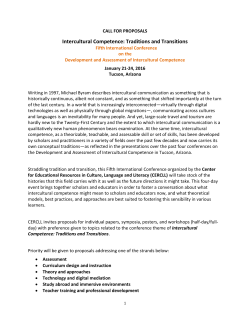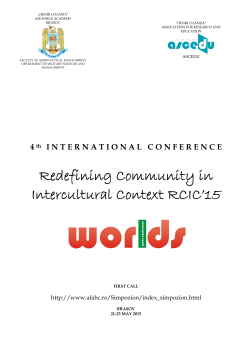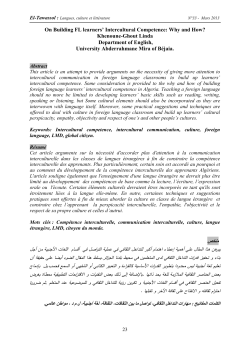
Improving Intercultural competence through online joint
Improving Intercultural Competence through Online Joint-Seminars with University Students from the U.S. and Sweden 7th COIL Conference @SUNY Center, NYC March 20, 2015 Mariya AIDA NIENDORF (Dalarna University, Sweden) mni@du.se Yumi TAKAMIYA (The University of Alabama at Birmingham) takamiya@uab.edu Background • In recent years, both the Swedish National Agency for Higher Education or Universitetskanslersämbetet (Högskoleverket) and individual universities in Sweden have been promoting ‘internationalization at home.’ • Incorporating development of intercultural competence in various courses has also been an important focal point of university education especially in the area of foreign language instruction. (Byram 1997) • It is often said that it is difficult for students to develop intercultural competence without an opportunity to study abroad or without having international students in the classroom. (Tyberg 2009 etc.) Purpose to provide opportunities for all students regardless of their international experience/background in order to develop intercultural-competence through language courses *Intercultural competence :The ability to communicate across cultures (interculturality) What is interculturality? Byram (2009) Interculturality refers to: • the capacity to experience and analyze cultural otherness • to use this experience to reflect on matters that are usually taken for granted within one’s own culture and environment • Interculturality involves: 1. being open to, interested in, curious about, and empathetic towards people from other cultures 2. using this heightened awareness of otherness to engage and interact with others and potentially, to act together for common purposes 3. evaluating one’s own everyday patterns of perception, thought, feeling and behavior in order to develop greater self-knowledge and self-understanding • Interculturality thus enables people to act as mediators among people of different cultures, to explain and interpret different perspectives. • Interculturality does not involve identifying with another cultural group or adopting the cultural practices of the other group. Previous Studies and Theoretical Framework • Quite a few studies regarding the development of intercultural competence through online exchanges (Helm 2009, Chun 2011, Schenker 2012, Kitade 2012, etc.) – Most of these exchanges, however, are between native speakers and learners of that language. • ‘Intercultural competence' is not just learning about the target culture, but also about becoming aware of one's own culture, and connecting students from different countries who are studying the same target language and culture would be an ideal setting in order for the students to evaluate both their own and target cultures critically (Byram 1997, Liaw 2006). The benefit of such exchanges may be maximized if both parties are learning the same foreign language and have the opportunity to utilize the language they are learning during the interaction. Questions to be answered 1) What do the students from different countries gain from this kind of exchange? 2) What can teachers do to make the students feel comfortable in seminars and meetings in order to maximize learning? 3) What processes are necessary for successful online exchanges with overseas students? Method Period: Spring semester 2012 Subjects A College in the East Coast (USA) All 7 students taking “Language and Identity” Advanced Reading, Composition, and Conversation Japanese class (intermediate – advanced level) A University in the Central Sweden (Sweden) 3 volunteer students from “Introduction to Linguistics” Japanese class (intermediate – advanced level) Method Blogs (entries on topics concerning identity issues by the US students and comments by both US & Swedish students, all in Japanese) Joint online seminars focusing on issues surrounding “identity,” 90 min x 2 (in Japanese) Post seminar surveysx2 (in English) Content of the Online Joint-Seminars Topics Seminar 1 – images of Japan Seminar 2 – various types of identity foreigners living in Japan foreigners living in the U.S./Sweden Japanese people living in the U.S./Sweden stereotypes relating to: Gender・age・origin/nationality・other groups individual student’s own identity/identities Format Warm ups and large group discussions Small group (2~3) discussions [partner changes] summary System Used (Adobe® Connect™) Results (from observation, surveys, & blog comments) • Students expanded their horizons and gained new perspectives by • • • • • discussing various topics with students from other countries who share the same interest (=Japanese language/culture). Positive effects on students developing interests in countries they previously did not have any interest in. Students seemed to feel less stressed speaking Japanese with other non-native speakers than to native speakers. It may take a longer period than just one term to build good relationships with students from partner institutions. Volunteer participants (students) were difficult to find. It is important to clarify the purpose of the exchange as we had some complaints from a few participants. Students who go into the project hoping only to gain Japanese language skills (grammar/vocabulary etc.) quickly become unsatisfied with the exchange. Mandatory vs. Volunteer Participation Pros and Cons of volunteer participation: + Those who volunteer are enthusiastic and actively participated in the exchange - - Only a few students are interested in participating If the teacher personally does not know the student, it is difficult to measure his/her language skills, personality, etc. Volunteers also tend to disappear in the middle of the project It is difficult to make meaningful connections between the course content and the activities in the online international exchange Findings from the Projects and Answers to the Research Questions 1) What do the students from different countries gain from this kind of exchange? 2) What can teachers do to make the students feel comfortable in seminars and meetings in order to maximize learning? 3) What processes are necessary for successful online exchanges with overseas students? 1.What do the students from different countries gain from this kind of exchange? • Identifying with each other • Avoiding stereotypes • No inferiority complex resulting in more active interaction • Sense of belonging • Critical reflection on one’s culture as well as use of Japanese language • Improved communicative skills in Japanese through real conversation • Expanding one’s horizons and perspectives of other cultures • Learning from each other’s different vocabulary repertoire → increase in number of vocabulary 2.What can teachers do to make the students feel comfortable in seminars and meetings in order to maximize learning? • Teachers from each institution need to communicate closely • • • • and openly (It is important for teachers from each institution to share the same purpose/trust and a good relationship between the teachers are important for successful exchanges) The teachers need to know their students (ability/personality) well Matching up students with similar language ability Breaking students into smaller groups (2~3 students per group) Assisting with activities and the choice of topics to be discussed 2.What can teachers do to make the students feel comfortable in seminars and meetings in order to maximize learning? • Providing a safe learning environment for the students Clarifying the purpose of the exchanges clearly to the participating students Preparing them to get to know each other prior to the actual face to face meeting. Choice of topics (from shallow to deep) Providing a longer period for discussion Help solving miscommunication problems (The teacher needs to be aware of any problems during the exchange and assist in resolving those problems.) 3. What processes are necessary for successful online exchanges with overseas students? Finding partner institution(s)/teacher(s): • Acquaintances • Making contacts at international conferences and workshops communicate closely and openly Selecting participating students: • Level (needs to be matched) • Volunteer vs. Mandatory (problems with time difference, family/work situation, different academic terms) • Teacher should know the participating students ability and personality well 3. What processes are necessary for successful online exchanges with overseas students? (cont.) Systems: • Use of readily available systems (google+, skype, skydrive, dropbox, facebook, etc.) • Synchronous (online video conferencing, online chat) vs. Asynchronous (email, blog, etc.) or Combination of both? Planing: • Period (need to consider different academic terms in different countries) • Frequency (more often the better) • Size (smaller group discussions – deeper relationship) • Topic (depends on the participants’ background / group combination; needs to be suitable for the purpose of exchange) • Activities (should incorporate both language skills as well as sharing one’s own perspectives) • Finding the right balance between students’ autonomous learning and teacher’s support Conclusion Changes in the students’ perspectives regarding their selfidentity and others’ identities. Stereotypes → realization of: Identity = various・multiple・fluid nature Difference → Similarity/Acceptance of differences Connection between language and society Critical thinking Life-long learning Problems with Byram’s IC model • The model is too theoretical – it is difficult to know exactly how to actually implement it in the classroom • The definition of what is 'culture', itself, is troublesome for the teachers (Byram: culture ≒ national culture) • Components of this model have hardly anything to do with language and also ignore the nature of communication itself such as the relational, interactional and developmental aspects (Matsuo 2012) • Difficult to assess The final words Through these types of exchanges, the students can gain not only Japanese skills, but also expand their horizons and deepen their understanding of another culture as well as of the topics discussed during the meetings through interactions with university students from other countries who study Japanese at the same level. The success of this project demonstrates a great potential in internetbased university education contributing to ‘internationalization at home’ and ‘improvement of intercultural competence’ for everyone. Not every student has the opportunity to study abroad, but today's technology allows every student to experience intercultural communication in a classroom setting. References Byram, M. (1997). Teaching and assessing intercultural communicative competence. Clevedon, UK: Multilingual Matters. Byram, M. (2009). Multicultural Societies, Pluricultural People and the Project of Intercultural Education, Language Policy. Division Council of Europe, Strasbourg. (www.coe.int/lang/ Platform of resources and references for plurilingual and intercultural education Box “The learner and the languages present in school”) Byram, M., Gribkova, B., & Starkey, H. (2002). Developing the intercultural dimension in language teaching: A practical introduction for teachers. Strasbourg, France: Council of Europe. Chun, D. M. (2011). Developing Intercultural communicative competence through online exchanges. CALICO Journal, 28 (2), 392-419. Helm, F. (2009). “Language and culture in an online context: what can learner diaries tell us about intercultural competence.” Language and Intercultural Communication, 9:2, 91-104. Högskoleverket. (2008). En högskola i världen: internationalisering för kvalitet. Högskoleverkets rapportserie 2008:15R. Kitade, K. (2012). An exchange structure analysis of the development of online intercultural activity. Computer Assisted Language Learning, 25 (1), 65-86. Liaw, M. (2006). “E-learning and the development of intercultural competence.” Language Learning & Technology 10:3, 49-64. Matsuo, C. (2012). “A critique of Michael Byram’s Intercultural Communicative Competence Model from the perspective of Model Type and Conceptualization of Culture.” Fukuoka University Papers in Humanities 44:2, 347380. Schenker, T. (2012). Intercultural competence and cultural learning through telecollaboration. CALICO Journal, 29(3), 449-470. Tyberg, E. (2009). Internationalisering: perspektivbyte, förhållningssätt och fredsprojekt. In Martin Stigmar, (Ed.). Högskolepedagogik: att vara professionell som lärare i högskolan, Chapter 12. Stockholm: Liber. Thank you! Mariya AIDA NIENDORF mni@du.se Yumi TAKAMIYA takamiya@uab.edu
© Copyright 2025

